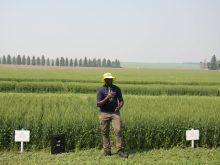A Canadian company that recovers phosphorus from waste-water treatment plants and turns it into fertilizer is planning a different type of fertilizer plant in St. Louis, Missouri.
Ostara, which has headquarters in Vancouver, has a patented technology to remove phosphorus from waste water and convert it into phosphate fertilizer.
It has installed such plants at cities around the globe, including Saskatoon, but its latest project does not involve waste water.
Its new facility in St. Louis, Missouri, which is expected to open this summer, will have the capacity to produce 200,000 tons of fertilizer annually. The granular fertilizer produced from the plant will be marketed as Crystal Green.
Read Also

Saskatchewan puts crown land auction on hold
Auctions of Saskatchewan crown lease land are once again on hold.
“The (fertilizer) that will be produced in St. Louis is a different process from the nutrient recovery systems,” said a company spokesperson. “Instead of recovering nutrients from waste water, St. Louis will start with an ammonium phosphate source, add proprietary ingredients, and process it through the granulation system.”
Ostara already operates a plant in Florida, which uses the same process to make Crystal Green fertilizer. The fertilizer from its waste water recovery systems is branded as Crystal Green Pearl.
“Crystal Green produced using our granulation facility has the same environmental and agronomic benefits of Crystal Green Pearl,” the spokesperson said.
Construction of the St. Louis plant is nearing completion. In mid-March, the U.S. Department of Agriculture invested $7.6 million to help the Ostara project over the finish line.
The funding was part of the USDA effort to increase production of “American-made fertilizer” and reduce dependence on imports from Russia and Belarus.
“By expanding the production of domestic fertilizer supplies, we can grow independent local businesses, bring production and jobs to rural communities and support fair prices for our farmers,” said U.S. agriculture secretary Tom Vilsack, in a USDA release.
The St. Louis plant represents a leap forward for Ostara in terms of volume of fertilizer. Its waste-water recovery installations, like the one in Saskatoon, produce only 300 tonnes of fertilizer annually.
Ostara was formed in 2005, based on technology developed at the University of British Columbia. A civil engineering professor at UBC patented a process to extract struvite from waste water and make pellets that can be used as fertilizer. The pellets, or granules, release nutrients slowly, reducing the risk of leaching and runoff associated with conventional fertilizers.
A company document from 2019 says Ostara has installed 22 waste-water recovery plants around the globe.


















